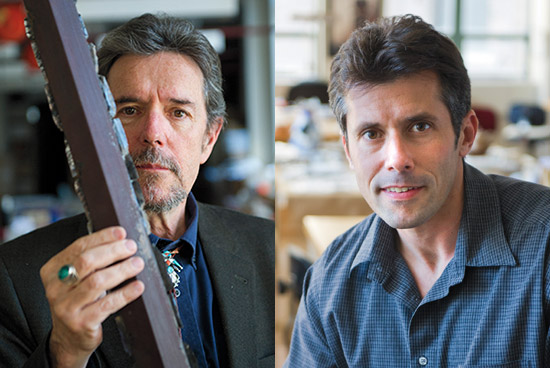Knapping Rocks
BU archaeology students make stone tools with stone tools
Eight people sit in a circle, mostly mute, intently cutting or chopping chunks of obsidian on their laps with tools—which, like the obsidian, are stone. Occasional banter and a chorus of chip–chip–chip–CRACK break the quiet, as the crew scrapes and smooths their stones, then whacks them to hew off larger pieces. Stone dust and chips litter the floor.
The group in the archaeology department’s Gabel Museum is practicing the ancient technology of knapping: fashioning stone artifacts with stone tools, variously obsidian, flint, and sandstone. David Carballo, a College of Arts & Sciences assistant professor of archaeology, guides their progress.
“I’m very rusty,” Carballo says. “This is going to end in blood or something.” At one point, wielding a precision cutting tool—a deer antler tip—in his right hand, he cautiously cradles the obsidian in his left. “This is where you could really hurt yourself, driving a flake off into your hand.”
No one doubts that napping while knapping can lead to unpleasant, self-inflicted surgery. As knapper Daniel Fallu (GRS’15) puts it, “Your femoral artery’s a really important part of your body.”
Archaeologists believe that our ancestors began making simple stone tools such as axes between 1.8 million and 2.6 million years ago. Then during the Acheulean period came a great technological leap forward, when they produced a more complex stone ax, as well as knives, cleavers, and other implements. On this night in 2013, the humans in CAS are doing their best to put a sharp edge on an eight-inch slab of obsidian.

“Some of these stone tools I can’t even make, and I’ve been doing it for a decade,” says Carballo, whose knapping session is part of his Introduction to Archaeology course. “It actually takes a high level of skill.”
As if to underline his point, pursing her lips, Ana Annicchiarico (CAS’14) emits a plaintive “Noooo,” after an excessively muscular blow obliterates her obsidian.
“This is where you make the strategic decision to go from spear point to arrowhead,” Carballo quips.
What is it about cutting rocks with rocks that brings this group together?
“There is something extremely primal, of course, about making stone tools,” says Carballo. “The archaeological record starts with stone tools. Before that, all we have are bones.”
Beyond their visceral pleasures, stone tools are a key barometer of human cognitive and cultural evolution. Those discarded chips—“garbage” in archaeolingo, Carballo says—are useful themselves, laden with information about how much was produced and what skills were required to sculpt a tool.
“That’s what’s so attractive about taking the class,” says Gabel Museum director Curtis Runnels, a CAS professor of archaeology, who has taught knapping at BU for 26 years. “Students can actually learn something about this ancient technology by touching not only real artifacts”—which fill the museum—but also by “replicating some of these artifacts, to understand what it took to actually do this in ancient times. You almost literally walk in the shoes of your prehistoric ancestors.”
Like their ancestors, the modern knappers leave “garbage,” and in deference to the Gabel janitor, Runnels offered Carballo some advice before his knapping session: “I don’t put it all in one trash can, ’cause the poor guy hates lifting that.”

Comments & Discussion
Boston University moderates comments to facilitate an informed, substantive, civil conversation. Abusive, profane, self-promotional, misleading, incoherent or off-topic comments will be rejected. Moderators are staffed during regular business hours (EST) and can only accept comments written in English. Statistics or facts must include a citation or a link to the citation.